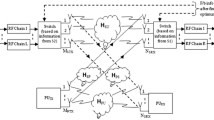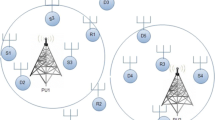Abstract
In this paper, a multiuser multiple-input-multiple-output, cognitive radio (CR) system has been analysed with transmit antenna selection (TAS) at CR base station transmitter and generalized selection combining GSC (N r , N c ) at each CR user. Multiuser diversity gain is obtained by selecting best CR user on the basis of instantaneous post processed signal-to-noise ratio (SNR) at the CR-Rx. The improved average post processed SNR and ergodic capacity of proposed TAS/GSC system is a function of best chosen receiver branches. The proposed TAS/GSC system is constrained by interference temperature limit ‘Q’ at primary user (PU) Rx, which degrades overall throughput hence peak power (P p ) of CR base station is set to be less than ‘Q’. We also derive analytic expressions for ergodic capacity and average post processed SNR. The simulation result validates with analytical result.









Similar content being viewed by others
References
Mitola, J., & Maguire, G. Q. (1999). Cognitive radio: Making software radios more personal. IEEE Personal Communications, 6(4), 13–18.
Khoshkholgh, M. G., Navaie, K., & Yanikomeroglu, H. (2010). Access strategies for spectrum sharing in fading environment: Overlay, underlay and mixed. IEEE Transactions on Mobile Computing, 9(12), 1780–1793.
Ghasemi, A., & Elvino, S. S. (2007). Fundamental limits of spectrum sharing in fading environments. IEEE Transactions on Wireless Communications, 6(2), 649–658. doi:10.1109/TWC.2007.05447.
Kang, X., Liang, Y. C., Garg, H. K., & Zhang, R. (2009). Optimal power allocation for fading channels in cognitive radio networks: Ergodic capacity and outage capacity. IEEE Transactions on Wireless Communications, 8(2), 940–950.
Eng, T., Tong, N., & Milstein, L. B. (1996). Comparison of diversity combining techniques for Rayleigh fading channels. IEEE Transactions on Communication, 44(9), 1117–1129.
Alouini, M. S., & Simon, M. K. (2000). An MGF based performance analysis of generalized selection combining over Rayleigh fading channels. IEEE Transactions on Communications, 48(3), 401–415.
Li, D. (2012). Performance analysis of MRC diversity for cognitive radio systems. IEEE Transactions on Vehicular Technology, 61(2), 849–853.
Zummo, S. A. (2008). Performance of coded systems with generalized selection diversity in Nakagami fading. EURASIP Journal on Wireless Communications and Networking,. doi:10.1155/2008/670503.
Cai, X., & Giannakis, G. B. (2004). Performance analysis of Combined Transmit Selection Diversity and Receive Generalized Selection Combining in Rayleigh Fading Channels. IEEE Transactions on Wireless Communications, 3(6), 1980–1983.
Thoen, S., Perre, L. V., Gyselinckx, B., & Engels, M. (2001). Performance analysis of combined transmit SC/receive MRC. IEEE Transactions on Communications, 49(11), 5–8.
Chen, Z., Yuan, J., & Vucetic, B. (2005). Analysis of transmit antenna selection/maximal-ratio combining in Rayleigh fading channels. IEEE Transactions on Vehicular Technology, 54(4), 1312–1321.
Win, M. Z., & Winters, J. H. (1999). Analysis of hybrid selection/maximal ratio combining in Rayleigh fading. IEEE Transactions on Communications, 47(12), 1773–1776.
Hanif, M. F., Smith, P. J., Taylor, D. P., & Martin, P. A. (2011). MIMO cognitive radios with antenna selection. IEEE Transactions on Wireless Communications, 10(11), 3688–3699.
Kong, A. H. Y. (2011). Ergodic and outage capacity of interference temperature limited cognitive radio multi-input multi-output channel. IET Communications, 5(5), 652–659.
Khan, F. A., Tourki, K., Alouini, M. S., & Qaraqe, K. A. (2014). Performance analysis of a power limited spectrum sharing system with TAS/MRC. IEEE Transactions on Signal Processing, 62(4), 954–964.
Blagojevic, V., & Ivanis, P. (2012). Ergodic capacity for TAS/MRC spectrum sharing cognitive radio. IEEE Communication Letters, 16(3), 321–323.
Torabi, M., Haccoun, D., & Ajib, W.(2009). BER performance analysis of multiuser diversity with antenna selection in MRC MIMO systems. In Global telecommunications conference. GLOBECOM, Honolulu. doi:10.1109/GLOCOM.2009.5425436.
Rasool, J., Hassel, V., de Ryhove, S. D. L. K., & O’ien, G. E. (2011). Opportunistic scheduling policies for improved throughput guarantees in wireless networks. EURASIP Journal on Wireless Communications and Networking, 2011, 43.
Ban, T., Choi, W., Jung, B., & Sung, D. (2009). Multiuser diversity in a spectrum sharing system. IEEE Transactions on Wireless Communications, 8(1), 102–106.
Lee, D., & Jeong, B. J. (2013). Performance analysis of scheduled cognitive radio systems with MIMO transmission. IEEE Transactions on Vehicular Technology, 62(8), 4088–4093.
Zhang, X., Lv, Z., & Wang, W. (2008). Performance analysis of multiuser diversity in MIMO systems with antenna selection. IEEE Transactions on Wireless Communication, 7(1), 15–21.
Knopp, R., & Humblet, P. A. (1995). Information capacity and power control in single cell multiuser communications. In IEEE international conference on communications, pp. 331–335. doi:10.1109/ICC.1995.525188.
Balakrishman, N., & Cohen, A. (1991). Order statistics and inference, estimation methods. New York: Academic.
Simon, M. K., & Alouni, M.-S. (2005). Digital communication over fading channels (2nd ed.). Hoboken: Wiley.
Gradshteyn, I. S., Ryzhik, I. M., Jeffery, A., & Zwillinger, D. (2007). Table of integrals, series and products (7th ed.). Amsterdam: Elsevier.
Perez, J., Ibanez, J., Vielva, L., & Santanmaria, I. (2005). Closed-form approximation for the outage capacity of orthogonal STBC. IEEE Communication Letters, 9(11), 961–963.
Author information
Authors and Affiliations
Corresponding author
Rights and permissions
About this article
Cite this article
Bindra, K.V., Sharma, S. & Khanna, R. Performance Analysis of Scheduled TAS Cognitive Radio System with Generalized Selection Combining. Wireless Pers Commun 95, 1567–1582 (2017). https://doi.org/10.1007/s11277-016-3867-7
Published:
Issue Date:
DOI: https://doi.org/10.1007/s11277-016-3867-7




